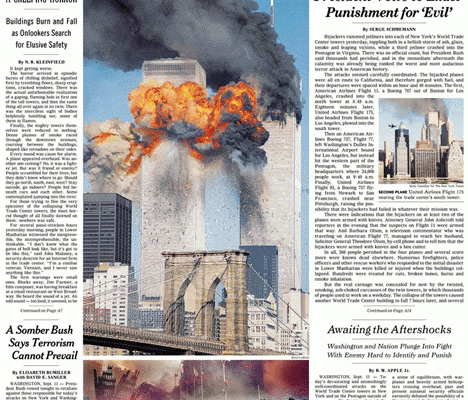
I’ve been thinking a lot recently about the changing way in which our society consumes information. In the past, most of us absorbed information in primarily text based formats. Newspapers are a perfect example of this phenomenon – front pages were far more text heavy than they are today, and authors tended to write longer form articles with in depth arguments. People would sit down and read the newspaper for long stretches of time to get their news for the day. However, with the rise of the internet, full color photography, and brilliant LED screens, we have all become a far more visually oriented. Today, we all prefer to consume our news in vivid technicolor, with accompanying visuals and photographs. To see this transition in action, let’s compare the front page of the New York Times after two similar landmark events – the Pearl Harbor bombing (Dec. 7, 1941) and the World Trade Center attacks (Sept. 11, 2001). Both major tragedies, both on American soil with American casualties. Compare the New York Times front page presentation of both at right.

The contrast is clear – the front page from 1941 is extremely text heavy, with only a single graphic and no photographs. The newspaper from 2001 is dominated by dramatic full color photographs, and text occupies less than 50% of the page. The photographs draw the reader in and convey much more emotion than the text alone. An interesting contrast, and a testament to both improved printing technology and our increasingly visual nature.
But the trend doesn’t stop with newspapers. I’m writing this post in the midst of “iPad mania” – Apple’s much anticipated tablet computer will be released in just 48 hours. I think that much of the hype around the iPad is due to the fact that so much of the experience Apple has designed is centered around consuming rich media – movies, comics, photos, and video. Even the vanilla e-book as been re-imagined – one of the launch titles is an illustrated guide to the periodic table, aptly titled The Elements. Instead of simply text and pictures, The Elements contains three dimensional samples and photos of each element: a nugget of gold (Au), an ingot of coal (C), a manganese crystal (Mn). You can touch and rotate them with your fingers. Tap to stream related videos from the internet or pull up the current market price of silver. What was once words on a page is now alive with information and rich media.
This kind of rich, visual media is definitely going to revolutionize not only textbooks, but literature of all types. Imagine a medical journal with anatomy models that rotate and zoom, or engineering manuals with diagrams that explode to show each and every part inside a car engine. As we discover ways to communicate more and more information visually instead of simply through text, I think the future is going to be a very exciting place to be.
Did this post help you? If it did, I'd love it if you'd sign up for my newsletter. I send out non-public stories, coaching tips, tricks, and funny stories every week. Enter your email address below.




Bill,nnYou have a good idea of how excited I am from a medical provider’s perspective. The iPad (but really the new tablet wave) opens the door for some amazing practical applications in addition to its rich media interface.nnFor instance:nnI can have all of my patient records stored in an app including HD digital x-rays easily and intuitively accessible.nnI could click on a medication listed in a patient’s medical history and see all of it’s drug-drug interactions and possible side effects through a linked reference program.nnHypothetically (if privacy can ever be reconciled with efficiency) a cloud based synchronization platform could result in a shared medical history between physicians/dentists/specialists/EMTs to provide more fully informed care at every step along the way.nnIn addition to all of the record keeping and reference ease, the tablet allows face to face patient communication coupled with note-taking capabilities resulting in a personal digital encounter rather than the desktop, head turned interview that I loathe.nnPatient scheduling is already made easy in digital format and in the App-based world of tablets should be very easy to inter-navigate through all facets of a practice. Also, it will essentially be pre-equipped as a signature pad to make prescription writing seamless (there are already very high-end machines that do a lot of this, but probably still not as well as Apple/Android Apps could).nnnI’m very excited and it’s interesting that implications in one sector can have similar yet different applications in another.nnAlso, learning applications, particularly for things like Anatomy and Oral Pathology that are largely image oriented will be incredibly handy.
Bill,
You have a good idea of how excited I am from a medical provider's perspective. The iPad (but really the new tablet wave) opens the door for some amazing practical applications in addition to its rich media interface.
For instance:
I can have all of my patient records stored in an app including HD digital x-rays easily and intuitively accessible.
I could click on a medication listed in a patient's medical history and see all of it's drug-drug interactions and possible side effects through a linked reference program.
Hypothetically (if privacy can ever be reconciled with efficiency) a cloud based synchronization platform could result in a shared medical history between physicians/dentists/specialists/EMTs to provide more fully informed care at every step along the way.
In addition to all of the record keeping and reference ease, the tablet allows face to face patient communication coupled with note-taking capabilities resulting in a personal digital encounter rather than the desktop, head turned interview that I loathe.
Patient scheduling is already made easy in digital format and in the App-based world of tablets should be very easy to inter-navigate through all facets of a practice. Also, it will essentially be pre-equipped as a signature pad to make prescription writing seamless (there are already very high-end machines that do a lot of this, but probably still not as well as Apple/Android Apps could).
I'm very excited and it's interesting that implications in one sector can have similar yet different applications in another.
Also, learning applications, particularly for things like Anatomy and Oral Pathology that are largely image oriented will be incredibly handy.
[…] in the spring of 2010, entrepreneur Bill Dalessandro wrote an article about the amazing transformation media had undergone from the 1950s through the 2000s. He wrote […]